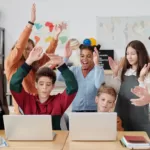Children’s programming was available as early as 1967.
LOGO language - the predecessor of Scratch
The first inspiration for developing Scratch was in 1967.
In the same year, Simer Paupt developed a programming language called LOGO, which is also the first programming language for children’s teaching in the world.
The representation result of the LOGO language output is a geometric figure. Since the cursor for drawing is a small turtle at the beginning, LOGO language is also affectionately called “Little Turtle Drawing”. In the world of LOGO programming language, children can write instructions on the keyboard to let the little turtle walk on the screen. The language and instructions are easy for children to understand, such as “forward 50” and “right 90”. By using these instructions, the little turtle will draw specific geometric figures on the screen.
Visual Programming Language - Scratch
The syntax of the LOGO language is very simple, but it cannot be visualized.
So some people think that it would be better if the programming language could be visualized. Then more children could learn easily.
Dr. Mickey Resnick and Dr. Seymour Peppert of MIT officially launched Scratch 1.0 in 2007.

In order to make children feel the fun of learning programming, the two doctors developed a visual programming language. Programming is no longer just letters and numbers, but a collage of images similar to building blocks. At the same time, they reduced the use of the keyboard, because the Scratch input mode is mainly the mouse. In this way, children can learn programming more easily and feel more interested.
Children don’t need to remember commands, but that doesn’t mean they don’t need to know commands.
The building block module includes 10 categories and more than 100 functions. It includes every line of code, every array, and every function required to form a complete program. The use of these graphical building blocks requires the correct guidance of teachers or parents. Through the process of imitation, children can perceive conditional sentences, circular sentences, and judgments. Understand the difference between parameters and commands. It is difficult for children to sum up by themselves, and guidance is necessary.
Achievements
In 2016, more than 120 million people visited the website, and 1 million people created and shared projects every month.
By 2021, Scratch has more than 20 million registered users. Scratch has been translated into more than 70 languages and is used in 150 countries.
Scratch had become the world’s largest children’s programming community.
Future: Scratch3.0
Scratch currently has version 3.0. I personally hope that everyone can use Scratch building blocks to rewrite our lives.
It is every Scratchmaker’s dream to be able to create a project through programming.






